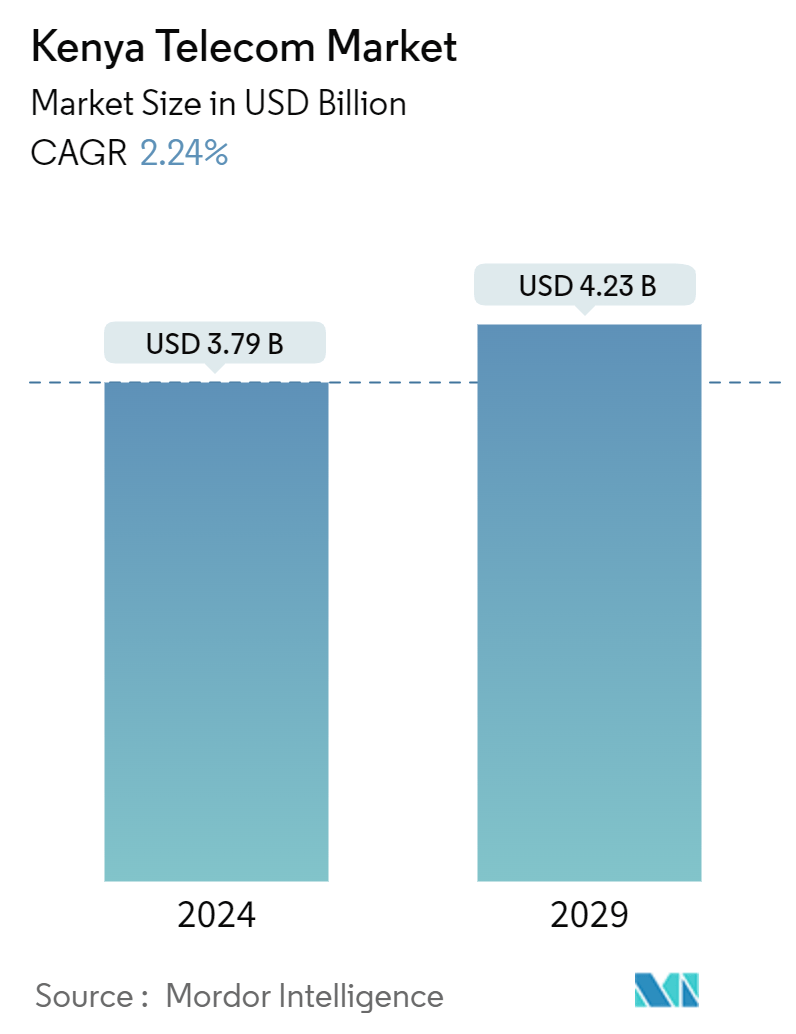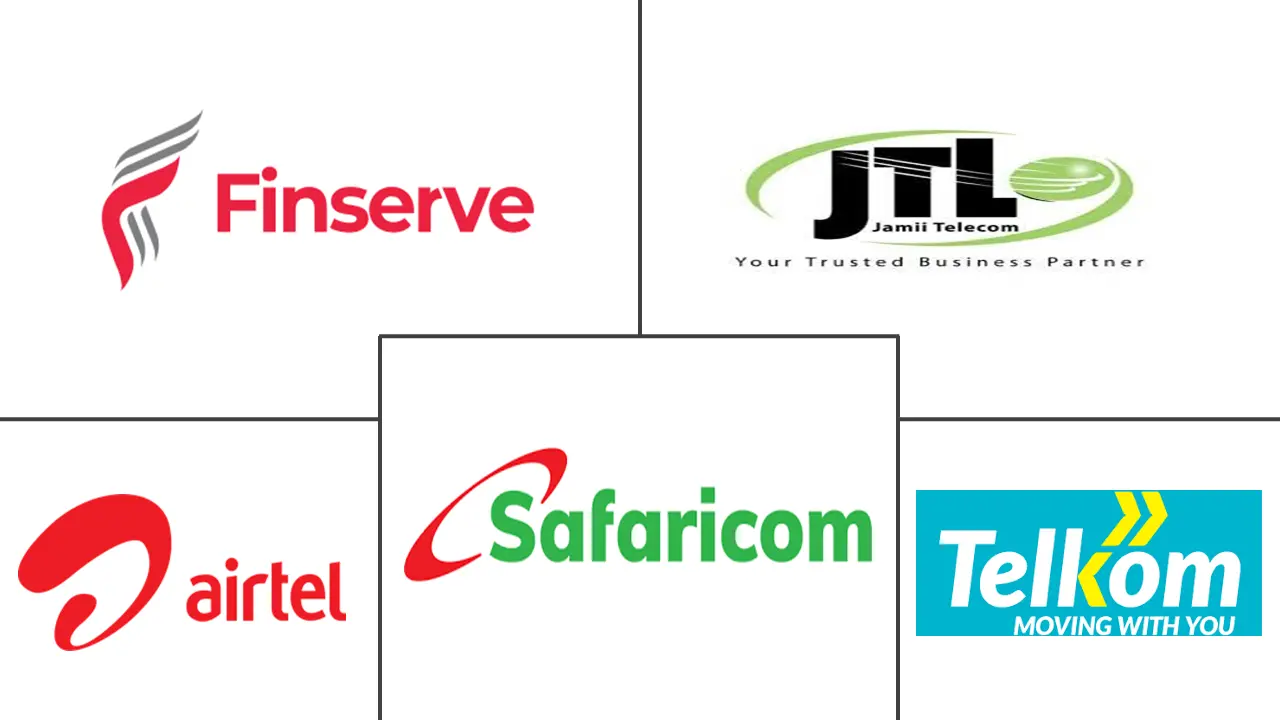Market Size of Kenya Telecom Industry

| Study Period | 2019 - 2029 |
| Base Year For Estimation | 2023 |
| Market Size (2024) | USD 3.79 Billion |
| Market Size (2029) | USD 4.23 Billion |
| CAGR (2024 - 2029) | 2.24 % |
| Market Concentration | Medium |
Major Players
*Disclaimer: Major Players sorted in no particular order |
Kenya Telecom Market Analysis
The Kenya Telecom Market size is estimated at USD 3.79 billion in 2024, and is expected to reach USD 4.23 billion by 2029, growing at a CAGR of 2.24% during the forecast period (2024-2029).
- Kenya's telecommunications sector is propelled by the increasing demand for mobile voice, data, and internet services. This increase is primarily fueled by a growing urban population and the widespread adoption of mobile phones that support 3G, 4G, and even 5G services in Kenya. Moreover, the country is a pioneer in money with services such as M-Pesa, which allows the market players to invest in innovation and growth, such as expanding financial inclusion and integrating mobile money with other services.
- Increased investments in 4G infrastructure have bolstered service quality and expanded its coverage. The rollout of 5G is planned to revolutionize connectivity, enabling a host of new applications, notably in the realm of IoT. In July 2023, Safaricom, a prominent Kenyan telecommunications company, partnered with AST SpaceMobile. Their collaboration aims to introduce a satellite internet service. Leveraging AST SpaceMobile's technology, this service will enhance broadband offerings, including Wi-Fi, cellular networks, and fiber optic cables, particularly targeting remote and rural areas.
- The high cost of deploying and maintaining telecom infrastructure, especially in remote and rural areas, is a barrier to market growth. The cost involved in laying fiber optic cables, setting up mobile towers, and acquiring spectrum licenses limits small players from expanding their networks and services.
- Post-COVID-19, companies experienced business transformation. Companies and individuals made investments in digital tools and services, including cloud computing, cybersecurity solutions, and e-commerce platforms. The government and regulatory bodies introduced supportive services for better connectivity, driving market growth.
- M-Pesa, the mobile money service, has grown significantly, catering to over 51 million customers in seven African nations. Notably, in partnership with Vodafone's Kenyan affiliate, Safaricom, M-Pesa expanded its mobile money services to Ethiopia, the continent's second most populous nation. Additionally, merchant payments and e-commerce activities are emerging as key drivers of this growth. As Vodaphone's clients increasingly embrace digital platforms, the companies are committed to offering them a seamless ecosystem for digital transactions, accessible through USSD or the M-Pesa Super App.
Kenya Telecom Industry Segmentation
Telecom or telecommunication is the long-range transmission of information by electromagnetic means. The telecom market includes in-depth trend analysis of connectivity, such as fixed networks, mobile networks, and telecom towers.
The Kenyan telecom market is segmented by services (voice services (wired and wireless), data and messaging services, OTT, and PayTV services). The market sizes and forecasts are provided in terms of value (USD) for all the above segments.
| By Services | ||||
| ||||
| Data and Messaging Services | ||||
| OTT and PayTV Services |
Kenya Telecom Market Size Summary
The Kenyan telecom market is experiencing a dynamic transformation driven by the increasing demand for mobile voice, data, and internet services. This demand is largely fueled by a growing urban population and the widespread adoption of advanced mobile technologies such as 3G, 4G, and 5G. The market is characterized by significant investments in infrastructure, particularly in 4G and 5G networks, which are enhancing service quality and expanding coverage. The rollout of 5G is expected to revolutionize connectivity, enabling new applications, especially in the Internet of Things (IoT) sector. Key players like Safaricom are leading these advancements, with strategic partnerships and initiatives aimed at enhancing broadband offerings and expanding financial inclusion through mobile money services like M-Pesa. Despite the high costs associated with deploying telecom infrastructure in remote areas, the market is witnessing growth due to increased digital adoption and supportive government policies.
The Kenyan telecom industry is semi-consolidated, with major players such as Safaricom, Airtel Kenya, and Telkom Kenya dominating the market. These companies are focusing on strategic partnerships and alliances to expand their customer base and enhance service offerings. The market is also seeing a surge in digital adoption, with e-commerce and digital payment platforms driving data consumption and necessitating reliable internet connectivity. The growth of data centers and investments in digital tools post-COVID-19 are further contributing to market expansion. However, challenges such as high infrastructure costs and the need for affordable 5G devices remain. The market's competitive landscape is marked by high firm concentration, with major players striving to increase their market share through innovative solutions and strategic collaborations.
Kenya Telecom Market Size - Table of Contents
-
1. MARKET INSIGHTS
-
1.1 Market Overview
-
1.2 Industry Ecosystem Analysis
-
1.3 Industry Attractiveness- Porter's Five Force Analysis
-
1.3.1 Bargaining Power of Buyers/Consumers
-
1.3.2 Bargaining Power of Suppliers
-
1.3.3 Threat of New Entrants
-
1.3.4 Threat of Substitute Products
-
1.3.5 Intensity of Competitive Rivalry
-
-
1.4 Assessment of the Macro Economic Factors on the Market
-
1.5 Regulatory Landscape in Algeria
-
-
2. MARKET SEGMENTATION
-
2.1 By Services
-
2.1.1 Voice Services
-
2.1.1.1 Wired
-
2.1.1.2 Wireless
-
-
2.1.2 Data and Messaging Services
-
2.1.3 OTT and PayTV Services
-
-
Kenya Telecom Market Size FAQs
How big is the Kenya Telecom Market?
The Kenya Telecom Market size is expected to reach USD 3.79 billion in 2024 and grow at a CAGR of 2.24% to reach USD 4.23 billion by 2029.
What is the current Kenya Telecom Market size?
In 2024, the Kenya Telecom Market size is expected to reach USD 3.79 billion.

